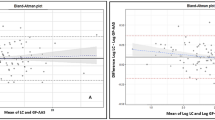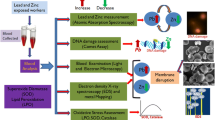Summary
The occupational or environmental exposure of selected populations to lead, either alone or in combination with other metals, was monitored using ratios of the activity of the erythrocytic enzyme δ-aminolevulinate dehydratase. The results obtained have reaffirmed earlier findings that this test affords several significant advantages over the use of the enzyme's activity value measured at a set pH value and other types of activity ratios to assess lead exposure. Furthermore, the activity ratios' proven sensitivity, reliability, reproducibility, specificity and stability warrant that they be considered as viable alternatives to the more widely accepted diagnostic criteria of lead intoxication namely zinc protoporphyrin and lead levels in blood.
Similar content being viewed by others
References
Abdulla M, Svenson S, Haeger-Aronsen B, Matheu A, Wallenius K (1978) Effect of age and diet on delta-aminolevulinic acid dehydratase in red blood cells. Enzyme 23:170–175
Assoc Offic Anal Chem Methods (1980) Metals and other elements as residues in foods, chap 25, pp 397–398
Bird TD, Hamernyik P, Nutter Y, Labbe RF (1979) Inherited deficiency of delta aminolevulinic acid dehydratase. Am J Hum Genet 31:662–668
Berlin A, Buchet JP, del Castillo P, Lauwerys R, Roels H, Smeets J (1974) Intercomparison programme on the analysis of Ph, Cd, and Hg in biological fluids. Int Symp Recent Advances in the Assessment of Health Effects of Environmental Pollution ECE-EPA-WHO, Paris
Davis JP, Avram MJ (1978) Sex-related differences in the reference values for erythrocytic δ-aminolevulinic acid dehydratase activity. Clin Chem 24:726–727
Farant J-P, Brissette D, Moncion L, Bigras L, Chartrand A (1981) Improved cold vapor atomic absorption technique for the microdetermination of total and inorganic mercury in biological samples. J Anal Toxicol 5:60–66
Fraske J-P, de Jeuw RA (1976) Differential pulse anodic stripping voltammetry as a rapid screening technique for heavy metal intoxications. Arch Toxicol 37:47–55
Granick JL, Sassa S, Granick S, Levere RD, Kappas A (1973) Studies in lead poisoning II. Biochem Med 8:149–159
Karacic V, Prpic-Majic D, Telisman S (1980) The relationship between zinc protoporphyrin (ZPP) and “free” erythrocyte protoporphyrin (FEP) in lead-exposed individuals. Int Arch Occup Environ Health 47:165–177
Lamolla AA, Yamane T (1974) Zinc protoporphyrin in the erythrocytes of patients with lead intoxication and iron deficiency anemia. Science 186:936–937
Mitchell RA, Drake JE, Wittlin LA, Rejent TA (1977) Erythrocyte porphobilinogen synthase (delta-aminolevulinate dehydratase) activity; a reliable and quantitative indicator of lead exposure in humans. Clin Chem 23:105–111
Olsen AD, Hamlin WB (1968) Serum copper and zinc by atomic absorption spectrometry. At Absorpt Newslett 7:69–74
Sakai T, Yanagihara S, Ushio K (1980) Restoration of lead-inhibited S-aminolevulinate dehydratase activity in whole blood by heat, zinc ion and (or) dithiothreitol. Clin Chem 26:625–628
Sassa S, Granick S, Bicher R, Levere RD, Kappas A (1973) Studies on the inheritance of human erythrocytic δ-aminolevulinate dehydratase and uroporphyrinogen synthase. Enzyme 16:326–333
Schaller KH, Mache K, Haas T, Mache W, Valestin H (1971) Die Methoden zur Messung der Aktivitdt des ALAD im Blut. EC Meeting, Erlangen
Smith JC, Butrimovitz GP (1979) Direct measurement of zinc in plasma by atomic absorption spectrometry. Clin Chem 25:1487–1491
Tola L, Nordman CH (1977) Smoking and blood lead concentrations in lead-exposed workers and in unexposed population. Environ Res 13:250–255
Tomokuni K (1974) δ-aminolevulinic acid dehydratase test for lead exposure. Arch Environ Health 29:274–281
Tomokuni K, Kawaniski T (1975) Relationship between activation of delta-aminolevulinic acid dehydratase by heat and blood lead level. Arch Toxicol 34:253–258
Wealthey B, Barbeau A, Clarkson TW, Lapham LW (1979) Methylmercury poisoning in Canadian Indians. The illusive diagnosis. Can J Neurol Sci 6:417–422
Wigfield DC, Farant J-P (1979) Factors influencing the pH-activity relationship of δ-amino-olevulinic acid dehydratase from human blood and their relevance to blood lead assay. J Anal Toxicol 3:161–168
Wigfield DC, Farant J-P (1981) Assay of δ-aminolevulinate dehydratase in 10 μl of blood. Clin Chem 27:100–103
Wigfield DC, Farant J-P, Goldberg C, MacKeen JE (1981) Interferences in the δ-aminolevulinic acid dehydratase assay. J Anal Toxicol 5:
Wigfield DC, Farant J-P (1982) Erythrocytic δ-aminolevulinate dehydratase activity as a function of pH. A study of activity ratios as biologic indicators of lead intoxication. J Applied Toxicol 2:139–144
Zielhuis RL (1975) Dose-response relationship for inorganic lead. I. Biochemical and haematological responses. Int Arch Occup Health 35:1–18
Zielhuis RL (1975) Dose-response relationship for inorganic lead. II. Subjective and functional responses — chronic sequelae-no-response levels. Int Arch Occup Environ Health 35:19–35
Zielhuis RL (1977) Second international workshop permissible levels for occupational exposure to inorganic lead. Int Arch Occup Environ Health 39:59–72
Yamaguchi S, Kalu S, Hirata Y, Matuo S, Matsumoto H, Shimozo N (1976) Effects and dose-response relationship of toxic metals. In: Nordberg GF (ed). Elsevier, Amsterdam, pp 445–463
Author information
Authors and Affiliations
Rights and permissions
About this article
Cite this article
Farant, J.P., Wigfield, D.C. Biomonitoring lead exposure with δ-aminolevulinate dehydratase (ALA-D) activity ratios. Int. Arch Occup Environ Heath 51, 15–24 (1982). https://doi.org/10.1007/BF00378406
Received:
Accepted:
Issue Date:
DOI: https://doi.org/10.1007/BF00378406




